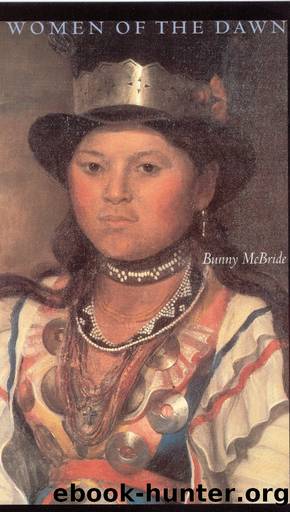Women of the Dawn by Bunny McBride

Author:Bunny McBride
Language: eng
Format: epub
Publisher: Nebraska
Published: 2020-12-23T00:00:00+00:00
While Penobscot boys gleaned the importance of hunting and warfare, Molly Molasses, like all Penobscot girls, came to appreciate the value of womenâs work. She learned how to raise corn and where to gather berries, lilyroots, fiddleheads, and waterfowl eggs. Her mother taught her how to scrape and soften animal hides and sew them into moccasins and clothing; how to fashion watertight bark containers and lash together a wigwam; and how to pluck a porcupine, flatten and dye its quills, and use them to embroider clothing and barkwork. Moreover, like every Penobscot child, male or female, Molly learned the benefits and hardships inherent in each season of the year and discovered the balance of firmness and flexibility needed to fit oneâs life to the variabilities of nature.
Perhaps most important, Molly learned about the Penobscot spirit world and mâteoulin (magic). As she listened to stories told by the elders and watched how her people lived, she came to understand that all life forms had a spirit force and that there was no line separating the natural from the supernatural. As for mâteoulin, it was a power given by the Great Spirit to a very few for the good of the whole. Those who possessed it were able to contend with unseen forces. They could interpret dreams, drive off disease or death, predict where game could be found, and send a bao-higan (spirit helper) to inflict harm on enemies. For generations mâteoulin had run in Mollyâs family, so no one was surprised when it became evident that Molly had this gift. As the years went by, magic, more than the everyday skills of women, would help her survive.
At odds with such beliefs were Catholic priests determined to save Indian souls. Building on the traditions of French âblackrobes,â Catholic priests from Canada visited Indian Island regularly during Mollyâs young years. In addition to giving religious instruction, hearing confessions, and performing marriage ceremonies, they baptized children and gave them Christian names. That is how she got her name: Mary Pelagie, which Wabanakis pronounced as Molly Balassee. Later in her life, white folks would make a word play on this and call her Molly Molasses.
During her childhood, Molly and her family centered their life on Indian Island, the tribeâs ancient gathering place. This 315-acre hump of land sat in the Penobscot River, thirty-five miles from the coast, just above a waterfall at the head of the tidal river. Most Penobscots came to Indian Island each spring to plant corn and in the fall to harvest it. Many also spent the winter months here, but they left the place often, traveling by river to seasonal fishing and hunting grounds. In the spring, a good number of them portaged around the falls and paddled their canoes downstream to the ocean to hunt seals. They camped en route in riverine coves and sometimes stayed in one spot for a week or more to fish. Molly knew all the ancient names of their traditional stopovers. The names revealed what could be found in each place.
Download
This site does not store any files on its server. We only index and link to content provided by other sites. Please contact the content providers to delete copyright contents if any and email us, we'll remove relevant links or contents immediately.
| General | Channel Islands |
| England | Northern Ireland |
| Scotland | Wales |
Room 212 by Kate Stewart(5040)
The Crown by Robert Lacey(4724)
Endurance: Shackleton's Incredible Voyage by Alfred Lansing(4677)
The Iron Duke by The Iron Duke(4293)
The Rape of Nanking by Iris Chang(4139)
Joan of Arc by Mary Gordon(4016)
Killing England by Bill O'Reilly(3953)
Say Nothing by Patrick Radden Keefe(3903)
I'll Give You the Sun by Jandy Nelson(3359)
Shadow of Night by Deborah Harkness(3305)
Hitler's Monsters by Eric Kurlander(3269)
Mary, Queen of Scots, and the Murder of Lord Darnley by Alison Weir(3152)
Blood and Sand by Alex Von Tunzelmann(3140)
Darkest Hour by Anthony McCarten(3072)
Eleanor & Park by Rainbow Rowell(3063)
Margaret Thatcher: The Autobiography by Thatcher Margaret(3029)
Red Famine: Stalin's War on Ukraine by Anne Applebaum(2873)
Book of Life by Deborah Harkness(2868)
The One Memory of Flora Banks by Emily Barr(2803)
